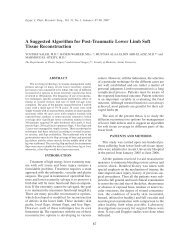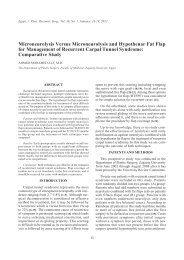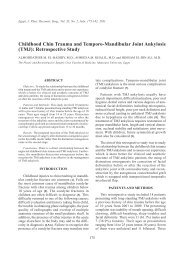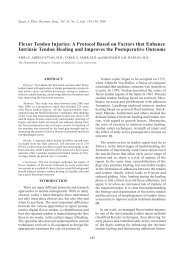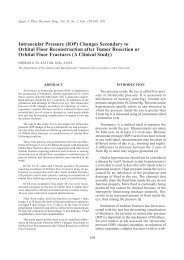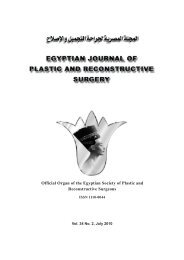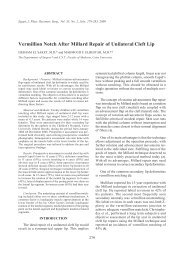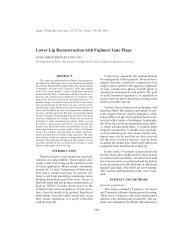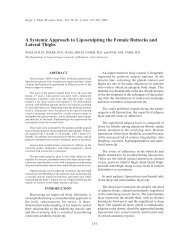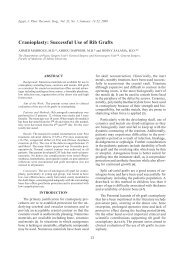The Para-Areolar Doughnut De-Epithelialization: A Useful ... - ESPRS
The Para-Areolar Doughnut De-Epithelialization: A Useful ... - ESPRS
The Para-Areolar Doughnut De-Epithelialization: A Useful ... - ESPRS
You also want an ePaper? Increase the reach of your titles
YUMPU automatically turns print PDFs into web optimized ePapers that Google loves.
Egypt, J. Plast. Reconstr. Surg., Vol. 36, No. 1, January: 87-90, 2012<br />
<strong>The</strong> <strong>Para</strong>-<strong>Areolar</strong> <strong>Doughnut</strong> <strong>De</strong>-<strong>Epithelialization</strong>:<br />
A <strong>Useful</strong> Approach for Grade III Gynecomastia<br />
OSAMA ALSHAHAT, M.D.<br />
<strong>The</strong> <strong>De</strong>partment of Plastic Surgery, Faculty of Medicine, Al-Azhar University, Cairo, Egypt<br />
ABSTRACT<br />
Breast hypertrophy with skin redundancy and ptosis of<br />
male breast cannot be managed by subcutaneous mastectomy<br />
alone. A technique is described in which the hypertrophied<br />
breast tissue and skin are reduced through a para-areolar deepithelialized<br />
ring which allows the nipple areolar complex<br />
mounted on a superior deepithelialised pedicle, to lie in a<br />
natural position. Surgery was done for twenty patients with<br />
grade III gynecomastia with a good aesthetic contour of the<br />
chest.<br />
Conclusion: <strong>The</strong> described technique can be considered<br />
less invasive that require minimal incision and may offer<br />
lower rates of complications.<br />
INTRODUCTION<br />
Gynecomastia is a benign enlargement of the<br />
male breast due to the proliferation of glandular<br />
breast tissue [1]. Gynecomastia may be seen in<br />
40% to 65% adult males [2]. <strong>The</strong> indications for<br />
the surgical treatment of gynecomastia are founded<br />
on the restoration of male chest shape and diagnostic<br />
evaluation of suspected breast lesions [2,3].<br />
El Noamani [4] adds the improvement of the international<br />
index score of erection following surgery<br />
of gynecomastia. Regarding surgery, no single<br />
technique appropriate for all grades of gynecomastia<br />
[5] and in an effort to tailor the technique to the<br />
situation Simon et al. [6] classifies gynecomastia<br />
into: Grade I is small enlargement without skin<br />
redundancy. Grade II is moderate enlargement<br />
without or with minor skin redundancy. While<br />
grade III is marked enlargement with skin redundancy<br />
and ptosis which simulate a pendulous female<br />
breast. Breast hypertrophy and/or ptosis corrective<br />
surgery on the skin and breast tissue is mandatory<br />
to obtain a good cosmetic result [7]. Saad and Kay<br />
[8] described the circumareolar incision that combines<br />
reducing the diameter of the areola and<br />
providing greater access for breast tissue. Also, it<br />
is known as doughnut-shaped de-epithelialization<br />
around the nipple [9]. Persichetti [3] believed that<br />
the complete circumareolar technique with purse-<br />
87<br />
string suture creates the best aesthetic results in<br />
patients with moderate and severe ptotic glandular<br />
breast enlargements that have skin redundancy<br />
combined with areolar enlargement. <strong>The</strong> nipple<br />
areola complex vascularity is maintained by a<br />
superior pedicle [9].<br />
In this article we described the para-areolar<br />
doughnut-shaped de-epithelialization technique<br />
for grade III gynecomastia to manage both skin<br />
redundancy and breast hypertrophy together with<br />
camouflaging the procedure.<br />
PATIENTS AND METHODS<br />
Between May 2006 and February 2010, a total<br />
of 20 male patients with severe gynecomastia<br />
(grade III) were treated using the para-areolar<br />
doughnut-shaped de-epithelialization technique.<br />
<strong>The</strong>ir mean age was 29 years (range 23 to 36 years).<br />
Patients were followed for 1-3 months postoperatively.<br />
Marking:<br />
Preoperative marking made with the patient in<br />
the standing position. It includes the midsternal<br />
line, a central circle including 4cm nipple-areolar<br />
complex diameter and a second concentric circle<br />
is marked outside the circumference of the original<br />
areola. <strong>The</strong>ir medial limit is 10-12cm from the<br />
midsternal line.<br />
Surgical technique:<br />
Tumescent fluid was injected in mammary<br />
tissue and intradermal in the ring between circles<br />
and mammary tissue. Next, these circles are lightly<br />
incised through epidermis only (Fig. 1). <strong>The</strong> ring<br />
of skin between them is de-epithelialized, leaving<br />
intact dermis and hence the dermal vascular plexus<br />
to nourish the nipple and areola (Fig. 2). A hemicircumferential<br />
incision from 4 to 8 o'clock made<br />
along the outer edge of the de-epithelialized ring,
88 Vol. 36, No. 1 / <strong>The</strong> <strong>Para</strong>-<strong>Areolar</strong> <strong>Doughnut</strong> <strong>De</strong>-<strong>Epithelialization</strong><br />
through dermis and subcutaneous tissue to gain<br />
access to the breast (Fig. 3). <strong>The</strong> hypertrophied<br />
breast tissue is dissected and freed from the pectoral<br />
fascia (Fig. 4). Removing proper amount from<br />
each side was done to obtain symmetricity. Hemostasis<br />
was done with cautery. A suction drain No.<br />
18 is inserted through a separate stab incision<br />
posterior to the anterior axillary line. Following<br />
the excision, 4 key sutures of the areola to the<br />
Fig. (1): Tumescent fluid was injected in mammary tissue and<br />
intradermal in the ring between the two circles and<br />
mammary tissue.<br />
Fig. (3): A semicircular incision, just inside the outer ring is<br />
made from 4-8 o'clock.<br />
Fig. (5): A purse-string suture to the<br />
outer dermal circle adjusted<br />
to 4 cm areolar diameter with<br />
3/0 Prolene.<br />
outer circumference of the de-epithelialized area<br />
was done with vicryl 3/0, burying the knots within<br />
the breast parenchyma to prevent postoperative<br />
exposure of the knot. A purse-string suture (Fig.<br />
5) to the outer dermal circle adjusted to 4cm areolar<br />
diameter with 3/0 Prolene and skin closure by 5/0<br />
Prolene simple sutures were done. Drains were<br />
removed with less than 50cm serous fluid. Twelve<br />
days were enough to remove simple sutures.<br />
Fig. (2): Intact dermis and hence the dermal vascular plexus<br />
to nourish the nipple and areola.<br />
Fig. (4): Breast disc excised. Note the available access.
Egypt, J. Plast. Reconstr. Surg., January 2012 89<br />
RESULTS<br />
Excellent cosmesis and excellent patient satisfaction<br />
rate were noted. <strong>The</strong> embarrassment about<br />
feminine appearance (80%) and tenderness (20%)<br />
were the major indications for operation. In spite<br />
of the disproportion between the two circumferences<br />
no difficulty was encountered providing the<br />
key and purse-string sutures. All patients achieved<br />
a good aesthetic contour of the chest (Figs. 6,7).<br />
<strong>The</strong> method described yields excellent shape, symmetry,<br />
and minimal unapparent scars. Haematoma<br />
on one side of a single patient (5%) was detected<br />
which required surgical evacuation. Bilateral seroma<br />
which necessitate multiple syringe aspiration<br />
for one patient (5%) was detected. <strong>The</strong> other complication<br />
was under-resection (5%). <strong>The</strong>re was no<br />
nipple areola ischemia, saucer defect or poor scarring<br />
encountered.<br />
(A) (B)<br />
Fig. (6A,B): 30-year old man with Preoperative very large pendulous breasts (bilateral grade III gynecomastia).<br />
(A) (B)<br />
Fig. (7A,B): One month post-operative with excellent chest contour and unapparent scars.
90 Vol. 36, No. 1 / <strong>The</strong> <strong>Para</strong>-<strong>Areolar</strong> <strong>Doughnut</strong> <strong>De</strong>-<strong>Epithelialization</strong><br />
DISCUSSION<br />
This study has used the described technique<br />
successfully to treat the hypertrophied mammary<br />
tissue, skin redundancy, simultaneously with safe<br />
transposition of the nipple and areola, and management<br />
of shape in grade III gynecomastia. Thus far,<br />
there has not been any need to revise the surgery.<br />
This approach provides excellent access and allows<br />
sculpt the underside of the nipple and areolar flap<br />
and the periphery of the breast to avoid the dishshaped<br />
deformity. Also the deepithelialised flap<br />
maintains vascular perfusion of the nipple-areolar<br />
complex and folds beneath it to give a natural<br />
projection after closure. Hidden periareolar scar<br />
with normal looking chest wall was the end result<br />
of this technique.<br />
Numerous techniques treat the grade III gynecomastia<br />
have been described. Rai [10] recommends<br />
two stages for post-weight problems with significant<br />
ptosis. While, Ward and Khalid [5] technique<br />
ends with a periareolar scar and transverse medial<br />
and lateral extension. Presented study reveals lower<br />
complication rate than Courtiss [11] who reviewed<br />
101 patients underwent subcutaneous mastectomy<br />
for gynecomastia.<br />
Conclusion:<br />
<strong>The</strong> described technique for breast hypertrophy<br />
with skin redundancy and ptosis of male breast<br />
can be considered less invasive that require minimal<br />
incision and may offer lower rates of complications.<br />
REFERENCES<br />
1- Narula H.S. and Carlson H.E.: Gynecomastia. Endocrinol.<br />
Metab. Clin. North Am., 36: 497-519, 2007.<br />
2- Hussain M.S.: Management of Gynecomastia. Suez Canal<br />
Univ. Med. J., 4: 9-15, 2001.<br />
3- Persichetti P., Berloco M., Casadei R.M., Marangi G.F.,<br />
Di Lella F. and Nobili A.M.: Gynecomastia and the complete<br />
circumareolar approach in the surgical management<br />
of skin redundancy. Plast. Reconstr. Surg., 107: 948-54,<br />
2001.<br />
4- El Noamani S., Thabet A., Enab A., Shaeer O. and El-<br />
Sadat A.: High Grade Gynecomastia: Surgical Correction<br />
and Potential Impact on Erectile Function. <strong>The</strong> Journal<br />
of Sexual Medicine, 7: 2273-9, 2010.<br />
5- Ward C.M. and Khalid K.: Surgical treatment of grade<br />
III gynecomastia. Annals of the Royal College of Surgeons<br />
of England, 7: 226-8, 1989.<br />
6- Simon B., Hoffman S. and Khan S.: Classification and<br />
surgical correction of gynecomastia. Plast. Reconstr.<br />
Surg., 51: 48-52, 1973.<br />
7- Gheita A.: Gynecomastia: <strong>The</strong> horizontal ellipse method<br />
for its correction. Aesthetic Plast. Surg., 32: 795-01, 2008.<br />
8- Saad M. and Kay S.: <strong>The</strong> circumareolar incision: A useful<br />
incision for gynaecomastia. Annals of the Royal College<br />
of Surgeons of England, 66: 121-2, 1984.<br />
9- Giele H. and Cassell O.: In: Giele H., Cassell O., editors.<br />
Aesthetic: Oxford specialist Handbook Surgery Plastic<br />
and Reconstructive Surgery, 1 st edition. New York, Oxford<br />
University Press Inc., 679-81, 2008.<br />
10- Rai K.: Sculpturing of the male breast. Can. J. Plast. Surg.,<br />
9: 33-6, 2001.<br />
11- Courtiss E.H.: Gynecomastia: Analysis of 159 patients<br />
and recurrent recommendations for treatment. Plast.<br />
Reconstr. Surg., 79: 740-53, 1987.





